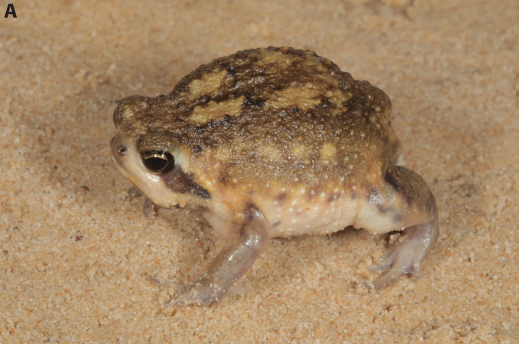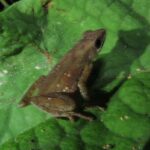- Introduction: Unveiling Breviceps carruthersi's Hidden World
- Taxonomy and Classification: Understanding Breviceps carruthersi’s Origins
- Natural Habitat: Secret Sanctuaries Amidst Southern Africa’s Forest Floor
- Physical Characteristics: The Elusive Charm of Breviceps carruthersi
- Behavior and Life Cycle: From Quiet Concealment to Subtle Courtship
- Ecological Importance: A Hidden Champion of Biodiversity
- Threats and Conservation Status: Securing a Future for Breviceps carruthersi
- Cultural and Scientific Significance: Embracing Nature’s Wonders
- Conclusion: Gathering Together for an Uncertain Hero
Introduction: Unveiling Breviceps carruthersi’s Hidden World#
In pockets of damp leaf litter beneath Africa’s southern forests hides an enchanting creature—a diminutive amphibian called Breviceps carruthersi. Affectionately known as Carruthers’ rain frog, or simply the Carruthers’ rain frog, this species reveals a world that is both charmingly secretive and astonishingly complex. With its unmistakable grumpy-faced demeanor and balloon-like body structure, Breviceps carruthersi captures the imagination of everyone fortunate enough to encounter it.
But beneath its whimsical appearance lies a wealth of biological intrigue and deep ecological significance. Found exclusively in select regions of Southern Africa, this small but resilient amphibian embodies the delicate balance within rich, biodiverse habitats. It may appear peculiar, even amusing, to casual observers—but to researchers and conservationists, the presence or absence of this frog holds profound indications about environmental health and habitat stability.
Let’s step quietly into the leaf-scented understory and shed some gentle light into the hidden avenues of Breviceps carruthersi, discovering its fascinating biology, habitat preferences, and the urgent conservation efforts necessary to ensure its survival.
Taxonomy and Classification: Understanding Breviceps carruthersi’s Origins#
Breviceps carruthersi belongs to the family Brevicipitidae, a fascinating group of short-legged and round-bodied frogs commonly known as rain frogs. Within this family lies the genus Breviceps, derived symbolically from Latin words meaning “short-headed,” a nod to their distinctively stout body shapes and reduced limbs. First officially described by researchers in the early 20th century, B. carruthersi honours Alexander Douglas Mitchell Carruthers, a British explorer and natural historian whose extensive work paved important pathways of understanding into Africa’s fauna.
Though fairly recently defined in taxonomic terms, advances in genetic sequencing continue to unfold details about its evolutionary relationships. Close relatives in the genus include the increasingly well-known desert rain frog (Breviceps macrops), famous for its viral squeaking calls, and the more widespread common rain frog (Breviceps adspersus). Each species in this remarkable genus has evolved unique behaviors and morphology, finely tuned to thrive amidst varying conditions, from desert sands to subtropical woodland floors.
Natural Habitat: Secret Sanctuaries Amidst Southern Africa’s Forest Floor#
The Carruthers’ rain frog occupies regions primarily within South Africa and Eswatini (formerly Swaziland). Unlike some of its desert-adapted relatives, this frog is firmly embedded within moist, temperate forests, favored by persistent humidity and rich soil chemistry. Known specifically from scattered but important localities within subtropical and montane forest ecosystems, the species seeks quiet refuge among decomposing leaves, fallen logs, and tangled root systems, sheltered from relentless sunlight and invasive predators.
Walking through these forests, one immediately senses their lush resilience—the perpetual symphony of insect sounds, the earthy scent of damp moss, and the persistent humidity filling the spaces between dense foliage. It’s in this shadowy sanctuary, beneath moss-encrusted tree branches, that B. carruthersi finds the moisture it needs for survival.
Such habitats provide both protection and sustenance; moisture is essential for maintaining their delicate skin, crucial for respiration, while leaf litter houses an abundance of prey and places of refuge. The precise mosaic of microhabitats within their geographic range offers ideal conditions, enabling the frogs to remain tucked away often entirely unnoticed by human visitors to these woodlands.
Physical Characteristics: The Elusive Charm of Breviceps carruthersi#
Despite rarely exceeding 45 millimeters in length, Carruthers’ rain frogs possess an outsized charisma. Perhaps its most striking feature—enough to garner instant recognition—is its distinctively round, stout physique that closely resembles a tiny inflated balloon. Its limbs are notably short, strong, and adapted for burrowing rather than high leaps or extended strolls. This amphibian moves through life at a measured, deliberate pace, using its pointed hind legs like shovels to immerse itself within moist earth rapidly when threatened or startled.
The frog’s vividly textured skin enhances its natural camouflage significantly. Shades of brown, grey, and olive blend seamlessly with leaf litter, mottled moss coverings, and bark textures around its forested home. The skin’s slight granulation provides additional texture and depth—perfectly mimicking wet soil and fallen foliage. Eyes that seem eternally thoughtful peer from a face expressive in its perceived discontent. Far from unhappy, however, this unusual appearance serves a fundamental purpose, deterring potential predators by helping it appear tougher and less palatable than it actually is.
Behavior and Life Cycle: From Quiet Concealment to Subtle Courtship#
Feeding Habits and Hunting Strategies#
B. carruthersi is a nocturnal predator, actively emerging from its hidden burrows beneath leaf litter as dusk blankets the forest. By nightfall, the forest floor comes alive with tiny insects and invertebrates—termites, ants, beetles, and small spiders—all pivotal to sustaining its diet. Gently walking across damp leaves, the frog remains alert and stealthy, lunging suddenly forward to engulf prey with a sticky tongue strike. Its nightly prowling helps regulate insect populations, effectively influencing forest-floor biodiversity.
A Remarkable Breeding Strategy#
Breeding season for this elusive species typically aligns with the rainy months when abundant moisture provides the ideal circumstance for nurturing offspring. Unlike many well-known amphibians that deposit eggs directly into water, rain frogs exhibit an intriguing terrestrial breeding strategy. Males, positioned atop leaf-laden ground within hidden territories, emit a characteristic call described as a quiet chirp or whistle, barely audible to the human ear unless intimately close.
Females drawn through these subtle cues engage in careful selection of mates. After brief but deliberate courtship interactions amongst leaf litter, communal burrows are excavated, and gelatinous egg clusters laid therein. Unlike traditional breeding modes defined by aquatic tadpole stages, Carruthers’ rain frog exhibits direct development. This extraordinary adaptation signifies that their offspring emerge fully formed froglets, bypassing vulnerable water-dwelling stages entirely—a strategy highly advantageous in environments where suitable water bodies might be absent or ephemeral.
Ecological Importance: A Hidden Champion of Biodiversity#
The subtle yet purposeful existence of B. carruthersi underscores an important ecological niche. Though small-bodied, these frogs profoundly influence insect diversity and density within their habitats, performing the important roles of prey and predator alike. They serve as nourishing sustenance for snakes, birds, and small mammals that quietly patrol these forest floors, highlighting their integral place in forest food webs.
Moreover, rain frogs are prime indicators of environmental health. Amphibians possess permeable skins, making them vulnerable to pollutants, climate shifts, and habitat disturbances. The presence or absence of robust populations sends an explicit environmental message, emphasizing the reciprocal interdependencies crucial for ecosystems to thrive. Thus, the health of Carruthers’ rain frog populations mirrors the broader health and functioning of forest habitats themselves.
Threats and Conservation Status: Securing a Future for Breviceps carruthersi#
Sadly, this delightful amphibian faces threats compounded by habitat destruction, climate unpredictability, and increasing human encroachment. While precise data is difficult due to their secretive nature, experts express concern about potential declines. Given these threats, B. carruthersi currently holds a classification of ‘Near Threatened’ by the International Union for Conservation of Nature (IUCN).
Proactive conservation measures emphasize safeguarding core habitats, implementing gentle forest management practices, and raising public awareness about this charming species amongst residents and policy-makers alike.
Cultural and Scientific Significance: Embracing Nature’s Wonders#
While culturally obscure to widespread attention, Breviceps carruthersi epitomizes biodiversity’s quiet significance to science. Biologists have studied its terrestrial breeding strategies extensively, revealing evolutionary adaptations beneficial to various ecological contexts. As climate change research intensifies, its role as a sensitive bioindicator continues to provide insights into habitat responsiveness and ecological resilience.
Conclusion: Gathering Together for an Uncertain Hero#
Ultimately, ensuring a viable future for Breviceps carruthersi revolves around informed, collaborative conservation efforts. By appreciating the hidden complexities of its life cycle, ecological roles, and significance to biodiversity, readers and conservationists alike can actively support protective measures, preserve habitats, and foster broader environmental awareness. Arm-in-arm, conservationists, scientists, and nature lovers across the globe share the important task of safeguarding this captivating frog—this tiny, enigmatic figure at home amidst the whispers of Southern African forests.









